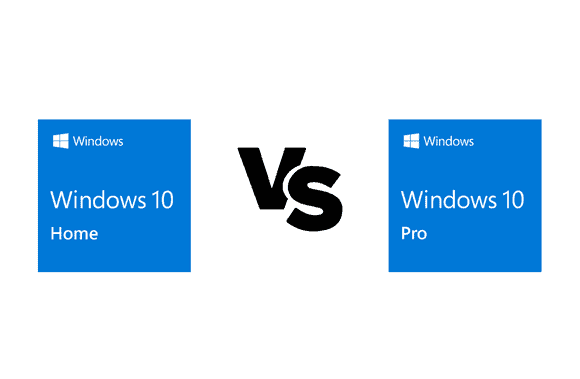Windows 10 Home VS Pro: Windows users have been torn between purchasing the Pro or the Home edition for years. Many people can therefore see the difference between Windows 10 Home and Pro.
After these two base versions, Windows 10 Pro for Workstations is Microsoft’s next-highest operating system. There are a few key distinctions between the Windows 10 Home and Pro editions, despite their shared commitment to a familiar user experience.
Everything from cost to features and capabilities is detailed. Let us quickly aid you in choosing between the two.
Windows 10 Home VS Pro: What Sets Them Apart?
Windows 10 Home is cheaper
Windows 10 Home and Pro differ mainly in pricing.
The Home version, suitable for most users, may be purchased for $139 and grants access to a single computer. If you’re curious, the price of Windows 10 Pro for a single PC is $199.99.
These retail licenses are not connected to a specific device and can be used on any compatible device. However, if you buy a computer with OEM Windows 10 already installed, you won’t be able to do this.
Windows 10 Pro has more features
Now, we’ll discuss what sets Windows 10 Pro apart from Windows 10 Home. The following are both standard and unique features of Windows 10 Pro.
Features available in both editions
- Microsoft Edge
- Cortana
- Windows Ink
- Windows Hello
- Your Phone
- Windows Security
- Secure Boot
- Windows Firewall
- Parental Controls
- Microsoft Office
- Microsoft Apps (Mail, Calendar, Photos, Paint 3D, etc.)
Additional Windows 10 Pro features
- BitLocker Encryption
- WIP (Windows Information Protection)
- Group Policy Editor
- Mobile Device Management
- Microsoft Azure (and related services)
- Kiosk Mode
- Assigned Access
- Windows Update for Business
- Microsoft Store for Business
Windows 10 Pro can support more CPUs, more RAM
Windows 10 Pro boasts more features, use more of your computer’s resources, and has a faster processor.
The Home model can only support one CPU, whereas the Pro edition can accommodate two.
In contrast to Windows 10 Home’s 128GB limit, Windows 10 Pro supports a whopping 2TB of RAM. With so much available memory, Google Chrome will think twice before becoming a RAM hog.
However, most users don’t need more than 16GB or 32GB RAM for standard applications and even high-performance games. Since both Windows 10 Home and Windows 10 Pro support DirectX 12 and 4K gaming, the Home edition is better if you’re on the fence.
Is Windows 10 Pro faster than Home?
There may be no discernible difference in boot times or program load times between Windows 10 Home and Windows 10 Pro when running on the same hardware. Windows 10 Pro, on the other hand, can make better use of those resources, making it a more robust and effective operating system when building a PC with mind-blowing technology.
No Windows Sandbox, Windows 10X emulator, Remote Desktop in the Home edition
You might want to try some things but can’t because the Home edition has restrictions. For instance, it does not help you run potentially harmful programs in a virtualized Windows environment using the new Windows Sandboxing security feature.
In the end, you can still use VirtualBox, but activating Windows will require a new key.
If you want to take command of your computer from afar, you can do so with Microsoft Remote Desktop. This function is not compatible with Windows 10 Home. TeamViewer and Chrome Remote Desktop are two examples of third-party apps that you can use in their place.
The emulator calls for Hyper-V functionality, which is missing from the Home edition; hence the Pro edition is also necessary for testing Windows 10X on your PC.
Which one to choose?
To address the question, “Is Windows 10 Pro better than Windows 10 Home?” Indeed, that is a positive reply. You can get by just fine with Windows 10 Home, though. With this package, you get everything you need, including Windows Security and other Microsoft programs. Also, no boundaries are set for how well third-party apps work together.
But let’s say you want to add a terabyte of memory to your machine and use business features like Bitlocker encryption, the Group Policy Editor and Azure Active Directory, and so on. Here’s where the Pro version shines. You can choose to upgrade from Windows 10 Home to Windows 10 Pro by paying the price difference.
Free Windows Updates for both Home and Pro
Since Windows 10, Microsoft has issued two major updates each year, in addition to monthly quality updates, to address user feedback and security and stability issues. Every Windows customer, Home or Pro, receives free updates from Microsoft’s Redmond headquarters. You shouldn’t let this stop you from making a purchase.
Another thing that both Windows 10 have in common is the length of time the company will support them. When a new feature update (H1 or H2 release) is made available, Microsoft supports it for 18 months before requiring customers to upgrade.
As you can see, these are the main differences between Windows 10 Pro and Home.



